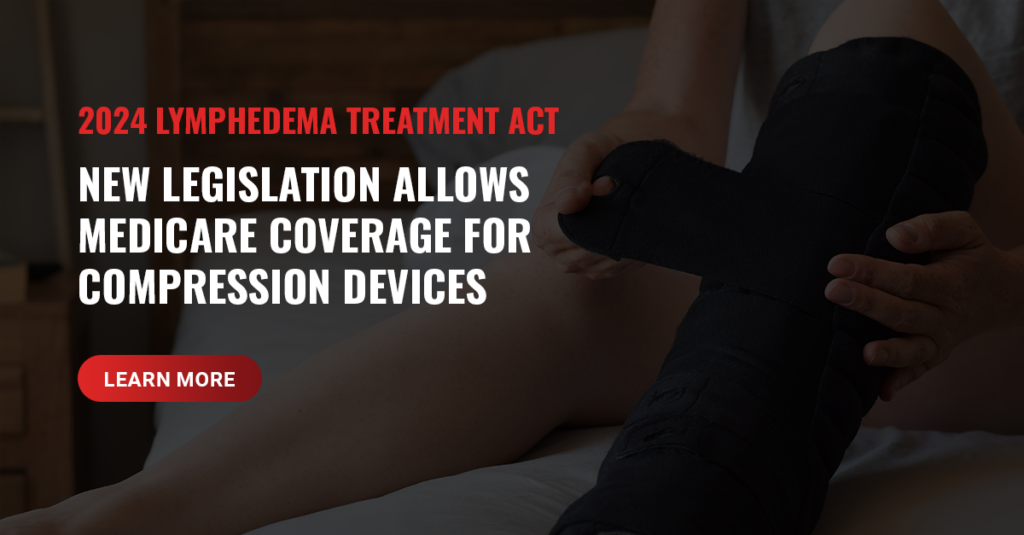The Lymphedema Treatment Act will go into effect in 2024 and allow for Medicare coverage for compression devices

For patients with Lymphedema, treatment is about to get much easier. On December 23, 2022, Congress passed the Lymphedema Treatment Act. And while it doesn’t go into effect until January 1, 2024, it does mean more treatment options for effected patients.
This act calls for Medicare to cover compression garments used to treat Lymphedema. Standard-fit and custom-fit compression garments will both be covered as well as compression garments for different body parts- not just arms and legs.
For compression devices to be covered, each patient will need a diagnosis of Lymphedema as well as a prescription. The bill is written that Medicare will cover compression devices for both patients with primary lymphedema and non-cancer related lymphedema.
While this only provides guidelines for patients that are on Medicare, it will benefit most patients. Most insurance companies follow Medicare coverage guidelines. Contact your health insurance provider to find out if you qualify for coverage.
How will the Lymphedema Treatment Act effect healthcare facilities?
This act gives physicians and patients more options for lymphedema treatment. Instead of recommending treatments that may not be covered by insurance companies, physicians can choose a product, write a prescription for the patient, and bill Medicare.
Now, doctors can help patients reduce out of pocket costs while providing additional treatment options. Facilities interested in offering additional compression devices to their patients do not have to worry about costs as everything will be billed back to Medicare. The Lymphedema Treatment Act solves a socioeconomic issue that many patients experience while improving overall health for patients.
What is Lymphedema?
Lymphedema is the chronic swelling of liquid build-up caused by a damaged lymphatic system, injury, or trauma. While there is no cure, there are definitely different ways to treat the problem and provide relief to patients.
Basic swelling and discomfort are mild symptoms, but this can lead to significant swelling, pain, and skin infections or wounds. Symptoms can range in severity and can prevent a patient from managing their daily activities.
Causes of Lymphedema
As previously mentioned, – lymphedema is caused by a damaged lymphatic system, injury, or trauma. While those are some of the main causes of the disease, here are additional things that could cause lymphedema:
- Breast cancer surgery
- Pelvic surgery
- Radiation therapy
- Infection
- Tumors
- Lack of activity
- Kidney disease
For those who are susceptible to lymphedema, there are measures to prevent the diagnosis. First and foremost: monitor your body. If a patient falls into any of the categories of causes for the disease, it’s critical to keep track of minor changes in the body such as swelling.
For those who have noticed swelling, it’s important to elevate the affected areas above the heart. Also incorporating movement can help reduce risk while preventing additional problems such as blood clots.
Aside from swelling, there are other lymphedema symptoms that patients should be aware of including:
- Loss of vein visibility in veins or tendons
- Arms or legs appear to be different sizes
- Joints are abnormally tight and have lost flexibility
- Skin appears puffy, red, or noticeably thicker
- Limbs feel heavy
- Jewelry or clothing fitting tighter than usual
If you are experiencing any of these symptoms, talk to your physician.
Lymphedema Diagnosis
There are two different diagnoses of lymphedema: primary and secondary. Primary lymphedema comes from genetics of the patient and how their lymphatic system developed. This is extremely rare only affecting 1 in 100,000 people across the U.S. This can be seen in infants born with Milroy’s disease, those experiencing puberty or pregnancy who are diagnosed with Meige’s disease, or those over 35 who experience late, onset lymphedema.
Secondary lymphedema is a direct result from system damage from surgery, trauma, or radiation therapy. Therefore, individuals who have received breast cancer treatment are at risk for lymphedema.
Once diagnosed, there are various stages of the disease:
- Stage 0: Swollen, tight, or heavy
- Stage 1: Occasional swelling that can be treated with elevation
- Stage 2: Swelling and firm skin surrounding the area
- State 3: Significant swelling with changes in color or texture of the skin
Treating Lymphedema
While there is no cure for lymphedema, there are various ways to provide comfort or treatment. Patients can elevate the effected area or exercise at home to help with lymphedema symptoms. There are also options as far as physical therapy goes or surgery. Although, surgery will not cure the diagnosis- only relieve symptoms.
The other options are compression garments/bandaging which will soon be covered in the Lymphedema Act.
The Lymphedema Treatment Act & DME Coverage
While this act states that Medicare will cover Lymphedema compression devices, there are a few guidelines as to what will be covered vs. not covered.
The act reads that ‘lymphedema compression treatment items’ can either be standard or custom fitted garments. The patient must have a formal diagnosis as well as a prescription in order to have compression devices or garments covered.
It’s expected that the bill honors patient choice when it comes to brand of the product prescribed. Currently pumps that can be utilized on compression devices are covered under the Durable Medical Equipment category and this act does not affect coverage for pumps.
The bill does cover pneumatic compression devices as well as static.
Of course, more details and restrictions will come out after the bill goes into effect on January 1, 2024, but right now it’s being interoperated that a patient can be prescribed two garments at one time with replacement every six months. Patient out-of-pocket costs will be 20%. Private insurance plan that follows Medicare’s instruction will differ.
To learn more, please read the Lymphedema Act here.
